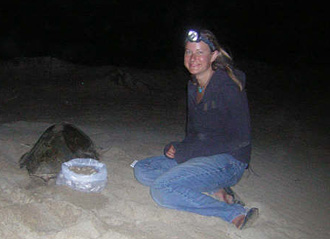Saving Sea Turtles from a Silent Death - 2
 Ariel Dueñas - PVNN Ariel Dueñas - PVNN


| | Don Cirilo Hernandez Ruiz, who has been taking care of sea turtles since the early 70's, celebrating Father's Day at Playon de Mismaloya with his grandson, Biologist Daniel Barreto. | 
| | A "Peladero" near La Cruz de Loreto. | 
| | Wild Travellers Director Ariel Dueñas with Teniente Carrillo. | 
| | New Zeland Park Ranger, Karen Ismay, working as volunteer in Mismaloya. |
"I think that eventually the poachers are going to eradicate all of them," says Don Cirilo Hernandez Ruiz, a legendary caretaker of turtles who recently retired from Mismaloya. Today, Ruiz is a solitary man who lives in the small town of 20 de Noviembre, where mankind's plundering of the natural resources in the surrounding jungle becomes more evident every day.

"Sea Turtles are born helpless and when hatching they confront many predators and a high risk of death," explains Biologist Daniel Barreto. "Maybe one or two will make it to adulthood, but, when left alone, those that are strong enough to survive can live for up to 100 years."

Sea turtles are migratory, traveling thousands of kilometers between the place where they are born to their permanent residence, the deep sea, where they eat different crustaceans or fish, and confront their worst enemy - the shark.

A testimony to 200 million years of evolution the Queloniousare, or sea turtles, once shared the oceans with the great dinosaurs. As a matter of fact, some amazingly big turtle species disappeared together with the plesiosaurious and ictiosaurious, which were some of the biggest animals at a time when the only continent, Pangea, was covered with amazing land life.

On any given day, a typical turtle poacher, know as a "caguamero" or "huevero," can be found on the beaches of Tomatlan. Riding along on his horse and dragging a long rope of dead turtles behind, he is usually accompanied by his dog, who is adept at detecting the slow movement of the turtles. These teams have the ability to move quickly and quietly across the sand dunes and disappear rapidly when they encounter a dangerous situation.

The poacher's typical "modus operandi" is always the same: they tie the turtle to a rope and drag it into the bushes where it is killed and pillaged - leaving behind only an empty shell.

"Some poachers have more respect," says one of the turtle protectors, "they don't kill the animals, they just take the eggs. Egg poaching is a common problem in Mismaloya, Chalacatepec, Teopa, Cuitzmala, El Tecuan, Mayto - basically all along the coast of Mexico, but the practice of killing the turtles is predominant in Mismaloya."

Even though the killers are silent most of the time, but sometimes they are confronted by young and unexperienced protectors and the poachers literally take the animals by force.

A girl saw it happen last night. " I hope that the marines and reenforcements arrive soon," she said, "because I couldn't do anything, they came, picked up the turtle right in front of me, took it behind the dunes and killed it viciously."

On our return to the camp, a live turtle burying future lives in the sand in front of El Hotelito Desconocido offered us a comforting site. In the end, she will go back to the raging sea, to swim beneath the foam of the great waves that break on this beach. |



